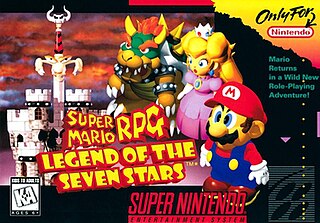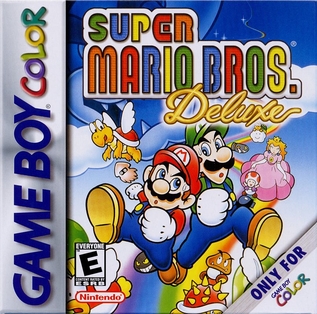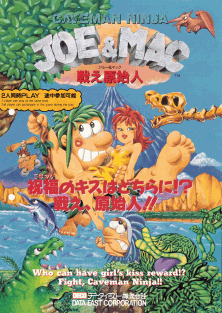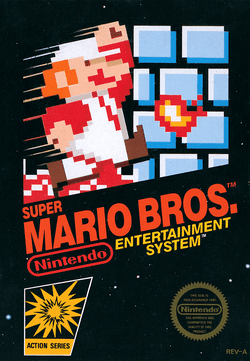
Super Mario Kart is a kart racing game developed and published by Nintendo for the Super Nintendo Entertainment System (SNES). The first game in the Mario Kart series, it was released in Japan and North America in 1992, and in Europe the following year in 1993. Selling 8.76 million copies worldwide, the game went on to become the fourth best-selling SNES game of all time. Super Mario Kart was re-released on the Wii's Virtual Console in 2009, on the Wii U's Virtual Console in 2013, and on the New Nintendo 3DS's Virtual Console in 2016. Nintendo re-released Super Mario Kart in 2017 as part of the company's Super NES Classic Edition.

Dr. Mario is a 1990 puzzle video game developed and published by Nintendo for the Nintendo Entertainment System, Famicom, and Game Boy. It was produced by Gunpei Yokoi and designed by Takahiro Harada. The soundtrack was composed by Hirokazu Tanaka.

Super Mario Bros. 3 is a 1988 platform game developed and published by Nintendo for the Nintendo Entertainment System (NES). It was released for home consoles in Japan on October 23, 1988, in North America on February 12, 1990 and in Europe on August 29, 1991. It was developed by Nintendo Entertainment Analysis and Development, led by Shigeru Miyamoto and Takashi Tezuka.

Super Mario World, known in Japan as Super Mario World: Super Mario Bros. 4, is a 1990 platform game developed by Nintendo EAD and published by Nintendo for the Super Nintendo Entertainment System (SNES). The player controls Mario on his quest to save Princess Peach and Dinosaur Land from the series' antagonist Bowser and the Koopalings. The gameplay is similar to that of earlier Super Mario games; players control Mario through a series of levels in which the goal is to reach the goalpost at the end. Super Mario World introduces Yoshi, a ridable dinosaur who can eat enemies.

Yoshi is a fictional dinosaur who appears in video games published by Nintendo. Yoshi debuted in Super Mario World (1990) on the SNES as Mario and Luigi's sidekick. Throughout the mainline Super Mario series, Yoshi typically serves as Mario's trusted steed. With a gluttonous appetite, Yoshi can gobble enemies with his long tongue, and lay eggs that doubly function as projectiles. Yoshi is the title character of the Yoshi series and a supporting character in Mario spin-off games such as Mario Party and Mario Kart, as well as many Mario sports games. He also appears as a playable character in the crossover fighting game series Super Smash Bros. Yoshi is a member of the same-named species, which is distinguished for its wide range of colors.

Princess Peach is a character in Nintendo's Mario franchise. She was created by Shigeru Miyamoto and introduced in the 1985 original Super Mario Bros. game as Princess Toadstool. She is the princess regnant and head of state of the Mushroom Kingdom, where she resides in her castle along with Toads. Since her debut, she has appeared in the majority of Mario video games as the main female character and the romantic interest of Mario. She has been voiced by Samantha Kelly since 2007.

Super Mario RPG: Legend of the Seven Stars is a 1996 role-playing game developed by Square and published by Nintendo for the Super Nintendo Entertainment System (SNES). It was the final Mario game published for the SNES. The game was directed by Chihiro Fujioka and Yoshihiko Maekawa, produced by Shigeru Miyamoto, and scored by Yoko Shimomura.

Super Mario Bros.: The Lost Levels is a 1986 platform game developed by Nintendo R&D4 and published by Nintendo. A sequel to Super Mario Bros. (1985), the game was originally released in Japan for the Family Computer Disk System as Super Mario Bros. 2 on June 3, 1986. Nintendo of America deemed it too difficult for its North American audience and instead released an alternative sequel, also titled Super Mario Bros. 2, in 1988. The game was renamed The Lost Levels and first released internationally in the 1993 Super Nintendo Entertainment System compilation Super Mario All-Stars. The game has since been ported to the Game Boy Color and Game Boy Advance, along with being re-released through emulation for the Wii, Wii U, Nintendo 3DS, and Nintendo Switch.

Mario Is Missing! is a 1993 educational game developed and published by The Software Toolworks for MS-DOS, Nintendo Entertainment System, and Super Nintendo Entertainment System, later released on Macintosh in 1994. The player controls Luigi, who must travel around the world to find and return stolen treasures as part of a quest to find his brother, Mario, who has been captured by Bowser. Mario Is Missing!, part of a series of educational Mario games, was Luigi's second starring role in a video game, following the 1990 Game Watch game Luigi's Hammer Toss and preceding the 2001 GameCube game Luigi's Mansion.

Wario's Woods is a puzzle video game developed by TEC and published by Nintendo for the Nintendo Entertainment System. It was released in Japan and North America in 1994 and Europe in 1995. A spin-off of the Mario series, players control Toad in his mission to defeat Wario, who has taken control of the Peaceful Woods. Gameplay revolves around clearing each level by using bombs to destroy groups of enemies. The game also features a multiplayer mode that allows two players to compete against each other.

Excitebike is a motocross racing video game developed and published by Nintendo. In Japan, it was released for the Famicom in 1984 and then ported to arcades as VS. Excitebike for the Nintendo VS. System later that year. In North America, it was initially released for arcades in 1985 and then as a launch game for the Nintendo Entertainment System later that year, becoming one of the best-selling games on the console. It is the first game in the Excite series.

Super Mario Bros. Deluxe is a 1999 video game developed by Nintendo for the Game Boy Color as a version of the 1985 game Super Mario Bros. for the NES. The game contains a largely unmodified version of Super Mario Bros. with an unlockable version of the 1986 Japanese sequel Super Mario Bros.: The Lost Levels. In addition, the game includes several new gameplay features, such as a single and two-player race mode, a challenge mode for individual levels, and miscellaneous toys and collectibles, some of which utilize the functionality of the Game Boy Printer.

Joe & Mac, also known as Caveman Ninja and Caveman Ninja: Joe & Mac, is a run and gun platform game released as an arcade video game by Data East in 1991. It was adapted for the Super NES, Mega Drive/Genesis, Nintendo Entertainment System, Game Boy, Amiga, Zeebo, Nintendo Switch, and IBM PC compatibles.

Hotel Mario is a puzzle video game developed by Fantasy Factory and published by Philips Interactive Media on the CD-i format on April 5, 1994. The player controls Mario, who must find Princess Toadstool by going through seven hotels in the Mushroom Kingdom; each hotel is divided into stages, and the objective is to close all of the doors on each stage. Each hotel ends in a boss fight with one of Bowser's Koopalings, culminating in a battle with Bowser.

Super Mario is a platform game series created by Nintendo starring their mascot, Mario. It is the central series of the greater Mario franchise. At least one Super Mario game has been released for every major Nintendo video game console. However, there have also been a number of Super Mario video games released on non-Nintendo gaming platforms. There are more than 20 games in the series.

Mario is a Japanese multimedia franchise created by Japanese game designer Shigeru Miyamoto for video game company Nintendo, which produces and publishes its installments. Starring the titular Italian plumber Mario, it is primarily a video game franchise but has extended to other forms of media, including television series, comic books, a 1993 feature film, a 2023 animated film, and theme park attractions. The series' first installment was 1983's Mario Bros., although Mario made his first appearance in 1981's arcade game Donkey Kong and had already been featured in several games of the Donkey Kong and Game & Watch series. The Mario games have been developed by a wide variety of developers, including Nintendo, Hudson Soft, and AlphaDream. Mario games have been released almost exclusively for Nintendo's various video game consoles and handhelds, from the third generation onward.

New Super Mario Bros. U is a 2012 platform game developed and published by Nintendo as a launch title for the Wii U. The game is a sequel to New Super Mario Bros. Wii and is the first entry in the Super Mario series to feature high-definition graphics.

Super Mario Bros. is a platform game developed and published in 1985 by Nintendo for the Famicom in Japan and for the Nintendo Entertainment System (NES) in North America. It is the successor to the 1983 arcade game Mario Bros. and the first game in the Super Mario series. Following a US test market release for the NES, it was converted to international arcades on the Nintendo VS. System in early 1986. The NES version received a wide release in North America that year and in PAL regions in 1987.

The Mario's Early Years! series is a trilogy of point-and-click educational games released on MS-DOS and Super Nintendo Entertainment System by The Software Toolworks. The three games consist of Fun with Letters, Fun with Numbers and Preschool Fun.





















